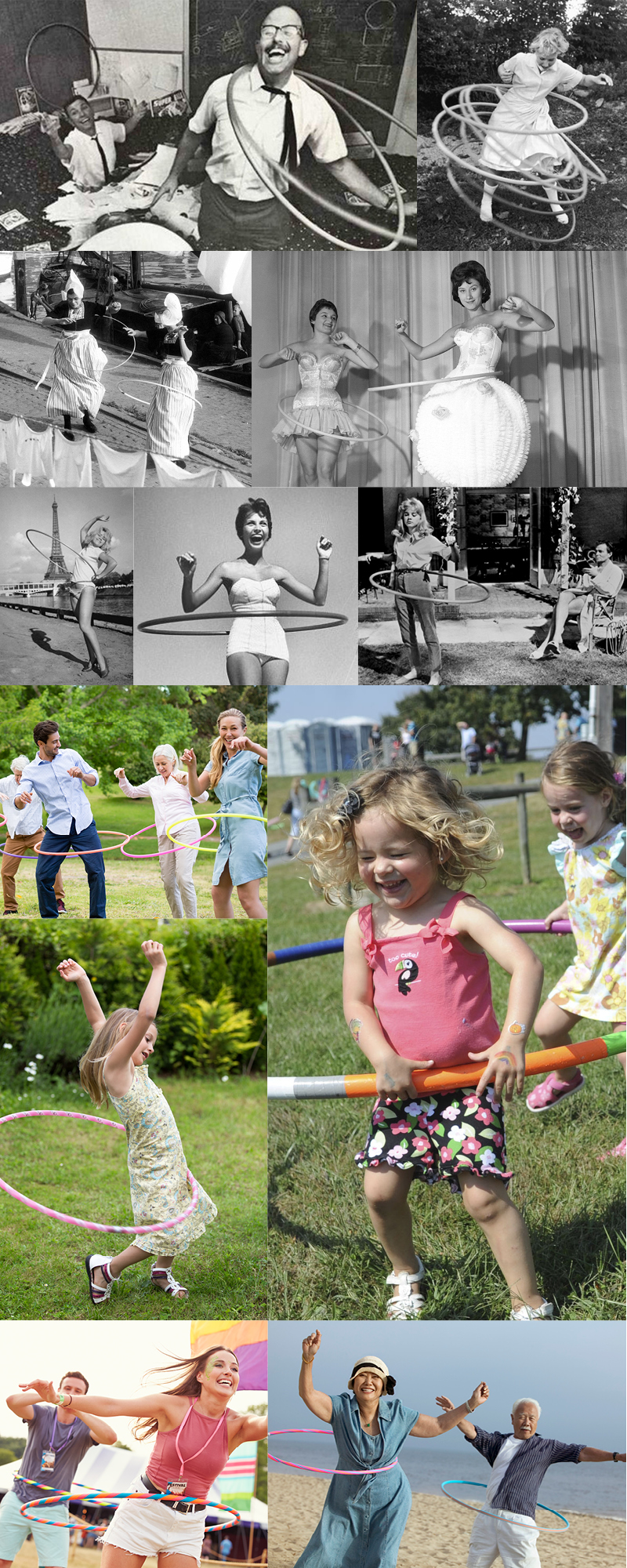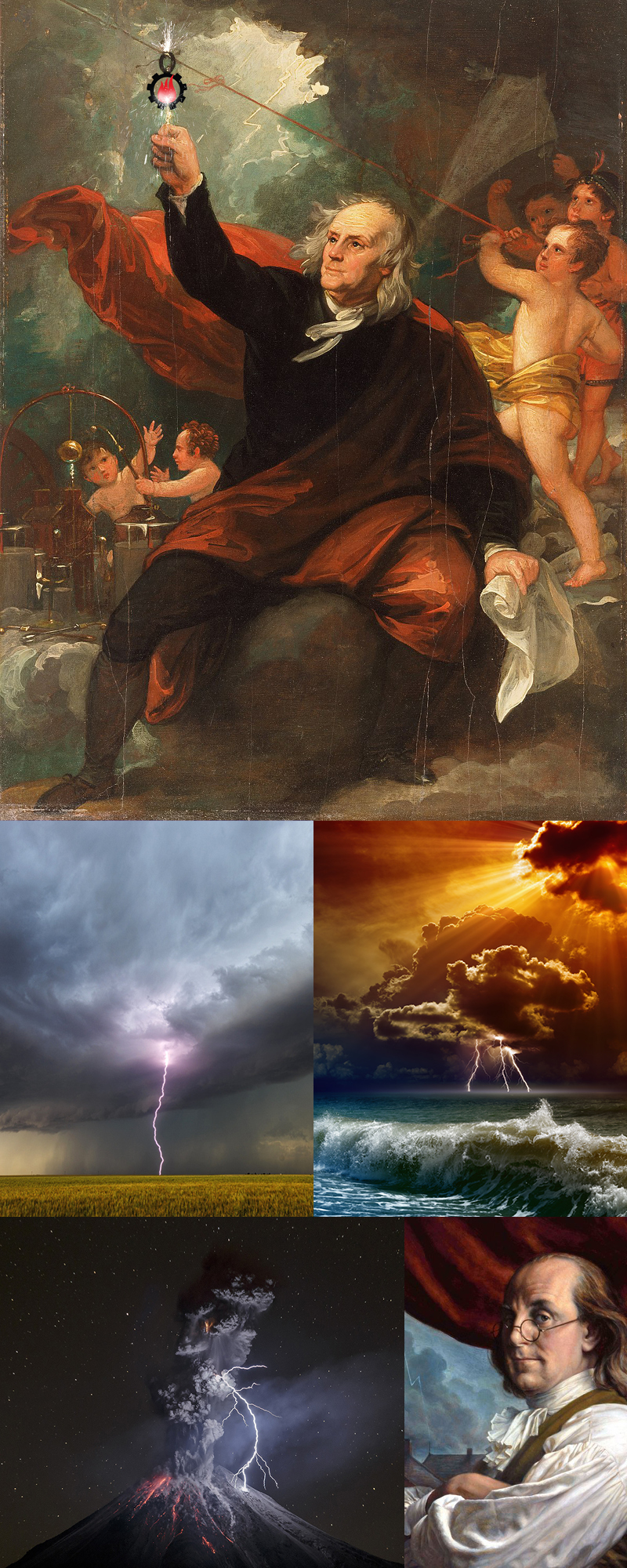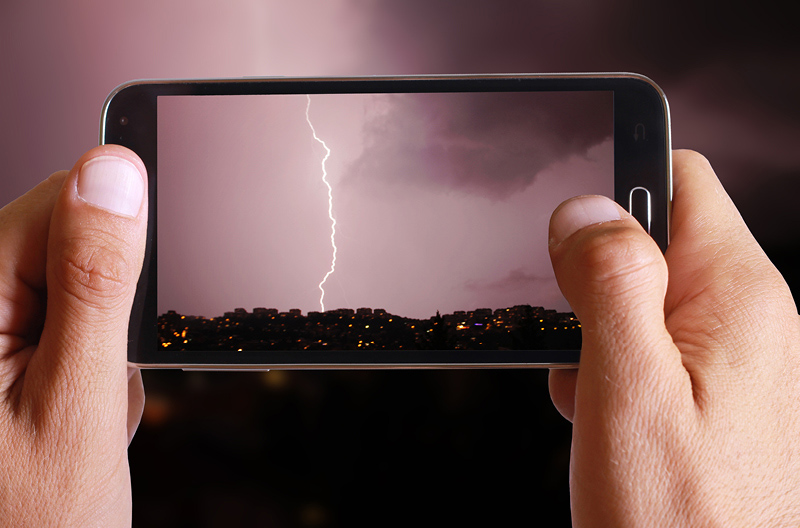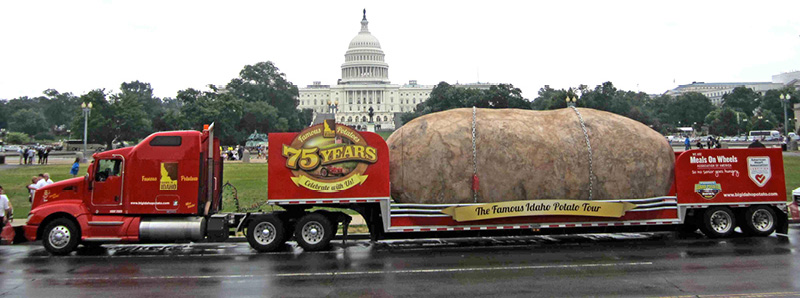Let’s Hoop It Up!

(row 1, l to r) Richard Knerr, foreground, and Arthur Melin, co-inventors of the Hula Hoop; 1958 was the beginning of the Hula Hoop’s incredible rise in global popularity. (row 2, l to r) Two housewives in Holland take a hula hoop break while hanging the wash; At a fashion show in Germany these models add hula hooping to the fashion show. (row 3, l to r) Hooping it up in Paris, France; Glasgow, Scotland; and in the 1962 film Lolita with Sue Lyon (hula hooping) and James Mason (sitting) directed by Stanley Kubrick. (the rest of the images) Hula hooping really is a great family activity or a solitary activity or a fun with friends activity— no matter your age.
Over the weekend I was digging in the back of the shed, looking for some lawn stuff, and came across on of the girl’s hula hoops. Wow, did that take me back. I remember how much fun they had in the driveway just spinning around, laughing. Now, keep in mind…I happen to be a spectacular hula hooper!! Just ask all of my ladies at home! Going online, I found out that the craze hit the US 50 years ago in the summer of ‘68, so I gathered some fun trivia for you to enjoy. Like many things from the 50’s, hula hoops have found a resurgence, and are now a staple with kids, exercise groups and meditating adults around the world. Thanks Wikipedia and Smithsonian for the info. Whirl away!
- A hula hoop is a toy hoop that is twirled around the waist, limbs or neck. The modern hula hoop was invented in 1958 by Arthur K. “Spud” Melin and Richard Knerr, but children and adults around the world have played with hoops, twirling, rolling and throwing them throughout history. Hula hoops for children generally measure approximately 28 inches in diameter and for adults around 40 inches.
- Now 94, Joan Anderson, the subject of the new documentary short Hula Girl, is finally getting her due for helping kick off the country’s hoop mania six decades ago. In 1957, while visiting family in Australia, she joined her cousins playing with a rattan hoop in the backyard. She brought the idea back to the U.S., and shared it with Spud Melin in the parking lot of the Wham-O plant. The rest just spun off from then on.
- The trademarked name evoked the still-exotic Territory of Hawaii and it’s sexy but still family-friendly hula dance and then launched a marketing campaign that was downright viral. The men took the hoops to Los Angeles parks, demonstrated the trick to kids and sent a hoop home with everyone who could keep it spinning. Company executives took the hoops on plane trips, hoping fellow passengers would ask about the odd carry-ons. And Wham-O tapped the powerful new medium of television with hokey, seemingly homemade advertisements. The word spread.
- Before it was known and recognized as the common colorful plastic toy (sometimes with water or sand inside the actual hoop), the traditional “hula hoop” used to be made of dried up willow, rattan, grapevines, or stiff grasses. Even though they have existed for thousands of years, they are often misunderstood as having been invented in the 50’s.
- According to authorCharles Panati, there was a “craze” of using wooden and metal hoops in 14th-century England. He reports that doctors treated patients suffering from pain and dislocated backs due to hooping − and heart failure was even attributed to it. Panati also says that the name “hula” came from the Hawaiian dance in the 18th century, due to the similar hip movements.
- Native American Hoop Danceis a form of storytelling dance incorporating anywhere from one to thirty hoops as props. These props are used to create both static and dynamic shapes, which represent various animals, symbols, and storytelling elements. The dance is generally performed by a solo dancer with multiple hoops.
- The hula hoop gained international popularity in the late 1950s, when a plastic version was successfully marketed by California’sWham-O toy company. In 1957, Richard Knerr and Arthur “Spud” Melin, starting with the idea of Australian bamboo “exercise hoops”. With giveaways and national marketing and retailing, a fad was started in July 1958, when twenty-five million plastic hoops were sold in less than four months, and in two years, sales reached more than 100 million units.
- Carlon Products Corporationwas one of the first manufacturers of the hula hoop. When the hula hoop craze swept the country, Carlon was producing more than 50,000 hula hoops per day.
- The hula hoop craze swept the world, dying out again in the 1980s, but not in China and Russia, where hula hooping and hoop manipulation were adopted by traditional circuses and rhythmic gymnasts.
- Recently there has been a re-emergence of hula hooping, generally referred to as either “hoopdance” or simply “hooping” to distinguish it from the children’s playform. The jam bandThe String Cheese Incident is widely credited with fostering a renewed interest in hooping. Band members started throwing larger adult-sized hoops into their audiences in the mid-1990s, encouraging their fans to hoop and dance, spreading the word and the fun. It wasn’t until 2003 with the launch of Hooping.org that these small bands of hoopers began to find each other online and a real community and movement began to grow.
- Bay Area Hoopers began in San Francisco at that time holding regular “hoop jams” with music to hoop to and the hooping group began being replicated in cities around the world. In 2006 Hoopin’ Annie had the idea to create a hooping holiday and the first World Hoop Day was held in 2007. Modern hula hooping is seen at numerous festivals and fairs in the USA, UK, Australia and Europe.
- Many modernhoopers make their own hoops out of PVC piping, or polypropylene tubing (known as polypro). The polyethylene hoops, and especially the polyvinyl chloride hoops, are much larger and heavier than hoops of the 1950s. The size and the weight of the hoop affect the style of the hooper. Heavier, larger hoops are more often used for beginner dancers and easier tricks, while lighter, thinner tubing is used for quick hand tricks. These hoops may be covered in a fabric or plastic tape to create more of a visual image and distinguish between the hoop and dancer. Gaffer Tape is also used to line the inside of a hula hoop to add grip or when using a bare hula hoop it can be roughened by using sandpaper. Some use glow-in-the dark, patterned, or sparkling tape, and others are produced with clear tubing and are never filled with materials (usually hoops for children are filled with an array of materials). LED technology and programmable ‘Smart Hoops’ are available which provide a range of special effects and some can even be customized through an application on a mobile device.
- Hooping now includes many ‘on body’ moves and many ‘off body’ moves. A few examples include breaks, isolations, leg hooping, and double hooping. Hooping has also become a popular fitness activity, with classes taking place in many towns and cities across the world. It is easy for beginners to get started with many great online resources popping up.
- After the sales blitz, sales never again reached those heights, yet the plastic child’s toy has evolved over the years into art, exercise, even a form of meditation. It has been adopted by both counterculture—it is a fixture at Burning Man—and digital culture. This summer, a company called Virfit introduced the Vhoop fitted with sensors and a Bluetooth transmitter to monitor a user’s every twist and turn via smartphone app, marrying the quintessential 1950s obsession to the latest fitness-tracking fad. The price got an update, too: Wham-O’s original hula hoop sold for $1.98; the Vhoop is a much more modern $119.
- The hoop was inducted into theNational Toy Hall of Fame at The Strong in Rochester, New York, in 1999.
RECORDS:
- 74 hours, 54 minutes– the longest verified record for keeping a hula hoop spinning is held by Aaron Hibbs fromColumbus, Ohio who kept a hoop spinning for 74 hours and 54 minutes between October 22, through 25, 2009. THIS MAN HAD WAY TOO MUCH TIME ON HIS HANDS!
- 245– most hula hoops caught and spun in one minute – Sheng Xue, China
- 39 seconds– fastest time to climb 50 stairs while hula hooping – Ashrita Furman, USA
- 16 Min. 13 Sec.– longest time to balance a hula hoop on head while swimming – David Rush, USA
- 203– most hula hoop rotations on the leg in one minute – Ashlee Male, UK
- 10in.– diameter of largest hula hoop spun – Yuya Yamada, Japan
- 71 seconds– Roman Schedler spun a 53-pound tractor tire for 71 seconds at the 5th Saxonia Record Festival inBregenz, Austria.
- 70 hoopers– on Team Hooprama hula hooped theMusic City Half-Marathon to raise awareness and funds for Hooping for Hope.
- 407 participants– the largest hula hoop workout (407 participants) was achieved atRavenscraig Regional Sports Facility in Scotland by North Lanarkshire Leisure and Powerhoop Fitness.








